As part of the Findhorn Hinterland Trust’s ongoing work to identify the biological diversity that occurs on the 35 hectares of land that we are responsible for managing, we commissioned a survey of the true bugs, or Hemiptera, and barkflies, or Psocoptera, on the site in the summer. This was carried out by Joe Botting, one of the UK’s leading experts on these groups of insects, over a period of three days at the end of July.
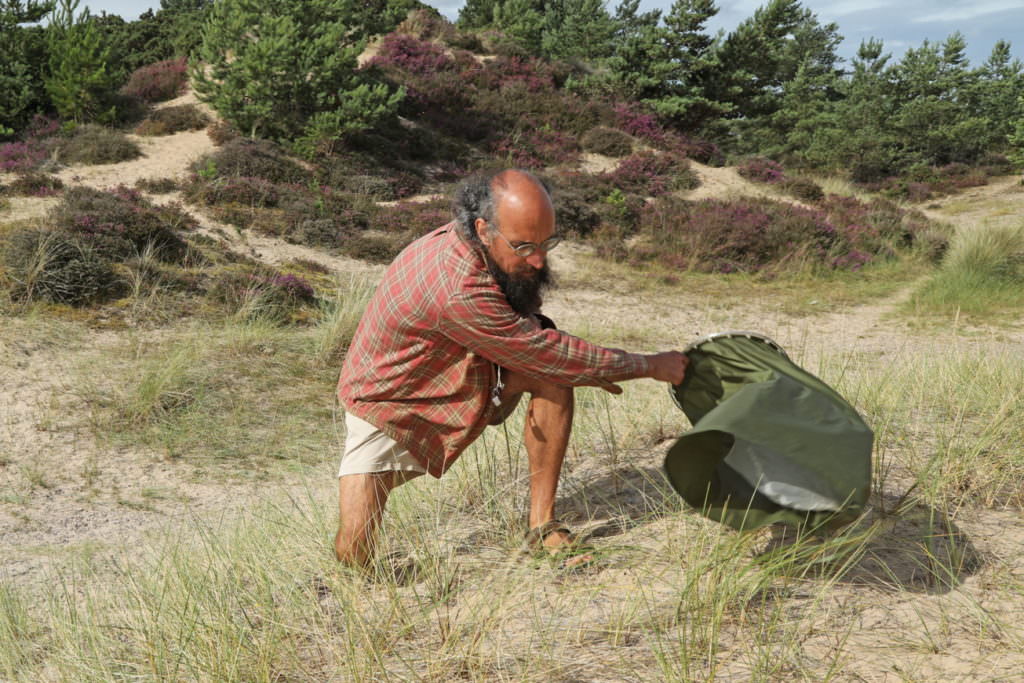
Joe Botting sweep netting for bugs in the dune area of the Findhorn Hinterland.
There are over 40,000 species of Hemiptera known to science, of which almost 2,000 have been recorded in the UK, and those include some well-known species such as the common froghopper (Philaenus spumarius) and various shieldbugs. By contrast, there is much less diversity within the Psocoptera, with a total of just 100 species having been recorded throughout the UK. Given the small size of the Hinterland site and the limited range of habitats we have on it, we did not expect to find a significant proportion of the UK species here, but Joe’s survey did result in the identification of 104 species of true bugs and 6 species of barkflies.
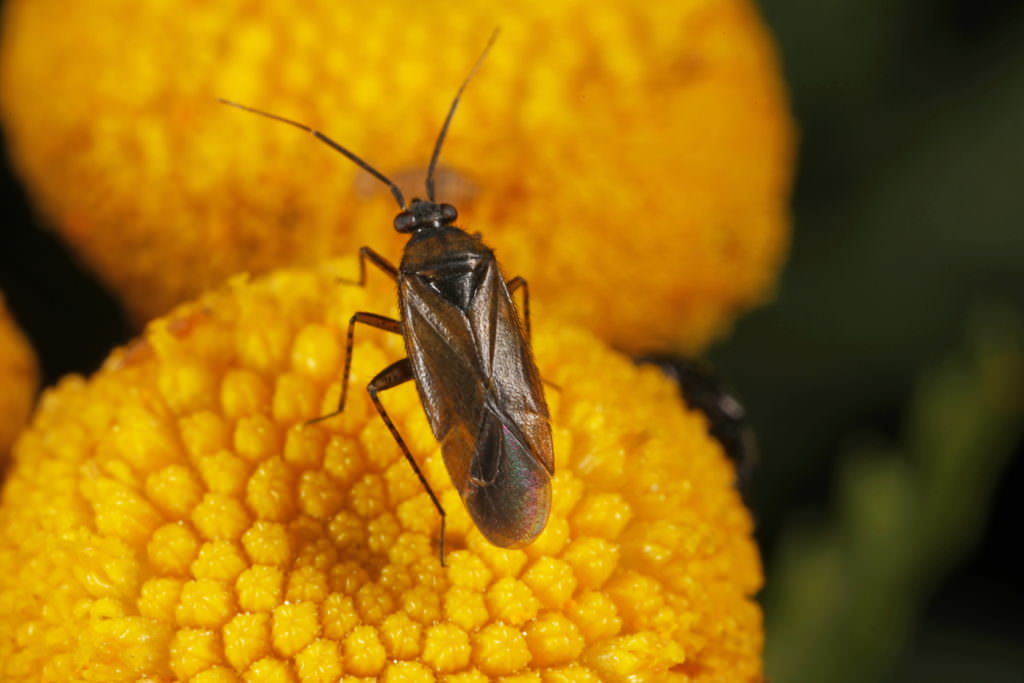
(Plagiognathus arbustorum) on a flower of tansy (Tanacetum vulgare), Findhorn Hinterland.
The occurrence and distribution of these insects varied across the different habitats on the site, with the old plantation of Corsican pines being the poorest in terms of both species and the actual numbers of bugs, whilst the dune slack area to the north of the woodlands contained both the greatest diversity and a number of scarce and interesting species. I accompanied Joe for most of the time he was carrying out the survey and was able to photograph quite a number of different bugs, including some of the scarce species.
Of particular note were a leafhopper (Gravesteiniella boldi) which occurs in coastal sandhills with marram grass and is very rarely recorded – this was the first record for Scotland, according to the National Biodiversity Network (NBN) Atlas – and a planthopper (Muirodelphax aubei), which has a mainly southern distribution in the UK (this was only the second record for it in Scotland on the NBN Atlas).
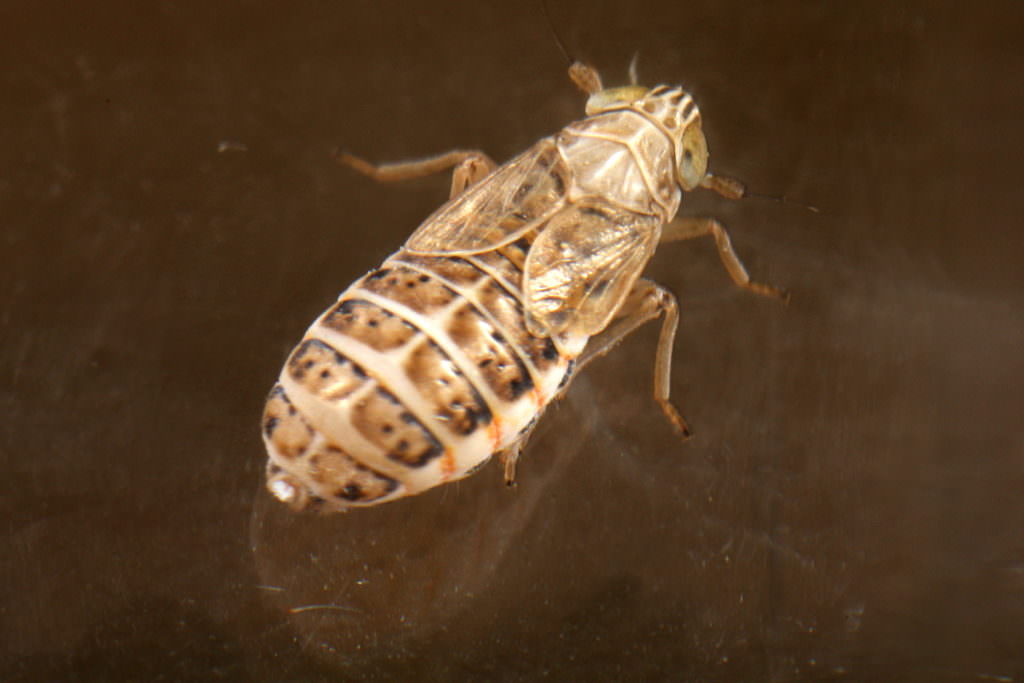
Leafhopper (Gravesteiniella boldi) found in a grass tussock, Findhorn Hinterland.
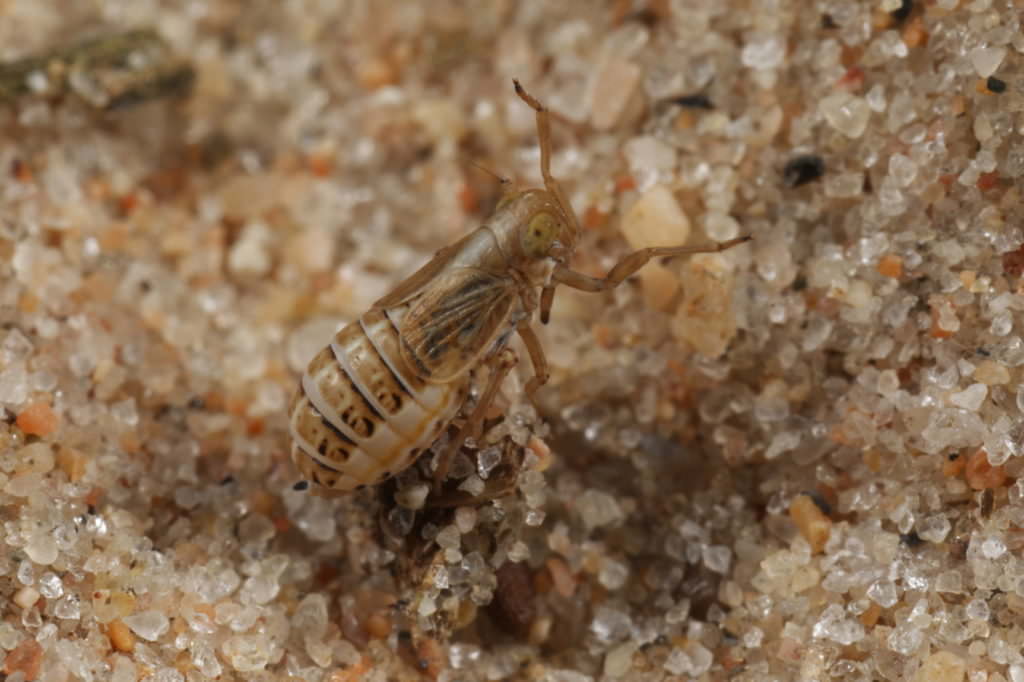
Planthopper (Muirodelphax aubei) on sand in the dunes on the Findhorn Hinterland.
Other species of particular interest included a planthopper (Macropsis fuscula) that has only been found once before in Scotland, at Gretna Green, and the blue shieldbug (Zicrona caerulea), for which this was the second most-northerly record in the UK. A poplar-associated leafhopper (Populicerus laminatus) that was found during the survey has only been recorded in the Highlands once before (on Trees for Life’s Dundreggan Conservation Estate in Glenmoriston), while this was the first Scottish records for a leafhopper (Edwardsiana crataegi) that is relatively common in the south of England and Wales.
The survey also recorded a lot of common and abundant species, including the parent bug (Elasmucha grisea). This is a shield bug that is named for the behaviours of the females in sheltering their eggs and the young nymphs for some time after they have hatched, to protect them from predators. This is a relatively rare example of parental care amongst insects! I’ve found parent bugs with their young in July in most years on the birch trees near the central wind turbine, and they were there again when Joe was on site.
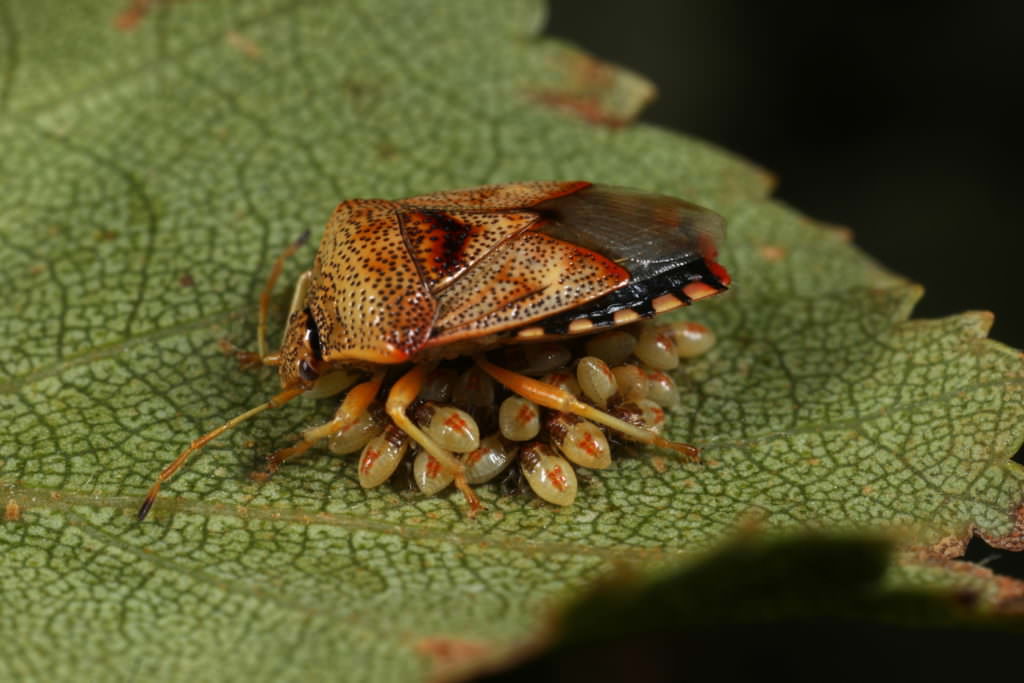
Female parent bug (Elasmucha grisea) brooding her young nymphs on a silver birch leaf (Betula pendula), photographed during Joe’s survey at the end of July.
This survey adds considerably to our knowledge of the diversity of true bugs on the Hinterland area. This is important both in and of itself, and also because of the fact that insects are almost certainly the most diverse groups of organisms on the land we care for (being much more numerous and diverse than birds, mammals, trees etc), with the Hemiptera and Psocoptera being important components of the insect community. Although bugs are not active in the winter, I hope the survey and this report will encourage Hinterland members and supporters to look out for these interesting and diverse insects after they emerge again next spring!
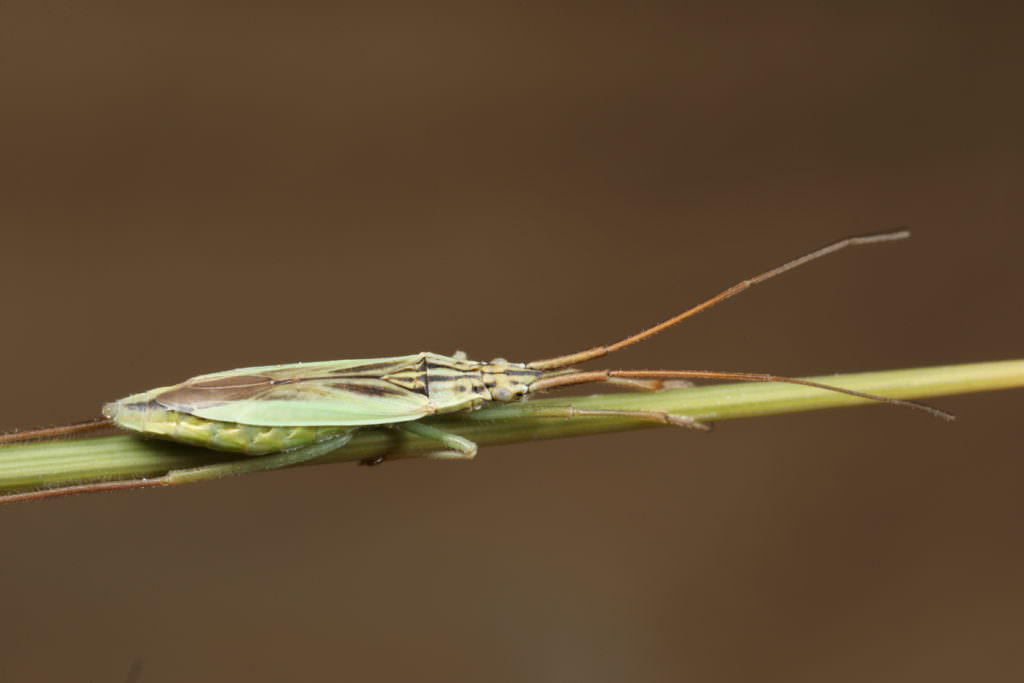
Elongated grass bug (Notostira elongata) on grass, Findhorn Hinterland.
With special thanks to Joe Botting for carrying out the survey, and for doing so at a discount from his usual rates.
Alan Watson Featherstone,
FHT Trustee & Chair of the Land Management subgroup.

Survey for True Bugs on the Hinterland
As part of the Findhorn Hinterland Trust’s ongoing work to identify the biological diversity that occurs on the 35 hectares of land that we are responsible for managing, we commissioned a survey of the true bugs, or Hemiptera, and barkflies, or Psocoptera, on the site in the summer. This was carried out by Joe Botting, one of the UK’s leading experts on these groups of insects, over a period of three days at the end of July.
Joe Botting sweep netting for bugs in the dune area of the Findhorn Hinterland.
There are over 40,000 species of Hemiptera known to science, of which almost 2,000 have been recorded in the UK, and those include some well-known species such as the common froghopper (Philaenus spumarius) and various shieldbugs. By contrast, there is much less diversity within the Psocoptera, with a total of just 100 species having been recorded throughout the UK. Given the small size of the Hinterland site and the limited range of habitats we have on it, we did not expect to find a significant proportion of the UK species here, but Joe’s survey did result in the identification of 104 species of true bugs and 6 species of barkflies.
(Plagiognathus arbustorum) on a flower of tansy (Tanacetum vulgare), Findhorn Hinterland.
The occurrence and distribution of these insects varied across the different habitats on the site, with the old plantation of Corsican pines being the poorest in terms of both species and the actual numbers of bugs, whilst the dune slack area to the north of the woodlands contained both the greatest diversity and a number of scarce and interesting species. I accompanied Joe for most of the time he was carrying out the survey and was able to photograph quite a number of different bugs, including some of the scarce species.
Of particular note were a leafhopper (Gravesteiniella boldi) which occurs in coastal sandhills with marram grass and is very rarely recorded – this was the first record for Scotland, according to the National Biodiversity Network (NBN) Atlas – and a planthopper (Muirodelphax aubei), which has a mainly southern distribution in the UK (this was only the second record for it in Scotland on the NBN Atlas).
Leafhopper (Gravesteiniella boldi) found in a grass tussock, Findhorn Hinterland.
Planthopper (Muirodelphax aubei) on sand in the dunes on the Findhorn Hinterland.
Other species of particular interest included a planthopper (Macropsis fuscula) that has only been found once before in Scotland, at Gretna Green, and the blue shieldbug (Zicrona caerulea), for which this was the second most-northerly record in the UK. A poplar-associated leafhopper (Populicerus laminatus) that was found during the survey has only been recorded in the Highlands once before (on Trees for Life’s Dundreggan Conservation Estate in Glenmoriston), while this was the first Scottish records for a leafhopper (Edwardsiana crataegi) that is relatively common in the south of England and Wales.
The survey also recorded a lot of common and abundant species, including the parent bug (Elasmucha grisea). This is a shield bug that is named for the behaviours of the females in sheltering their eggs and the young nymphs for some time after they have hatched, to protect them from predators. This is a relatively rare example of parental care amongst insects! I’ve found parent bugs with their young in July in most years on the birch trees near the central wind turbine, and they were there again when Joe was on site.
Female parent bug (Elasmucha grisea) brooding her young nymphs on a silver birch leaf (Betula pendula), photographed during Joe’s survey at the end of July.
This survey adds considerably to our knowledge of the diversity of true bugs on the Hinterland area. This is important both in and of itself, and also because of the fact that insects are almost certainly the most diverse groups of organisms on the land we care for (being much more numerous and diverse than birds, mammals, trees etc), with the Hemiptera and Psocoptera being important components of the insect community. Although bugs are not active in the winter, I hope the survey and this report will encourage Hinterland members and supporters to look out for these interesting and diverse insects after they emerge again next spring!
Elongated grass bug (Notostira elongata) on grass, Findhorn Hinterland.
With special thanks to Joe Botting for carrying out the survey, and for doing so at a discount from his usual rates.
Alan Watson Featherstone,
FHT Trustee & Chair of the Land Management subgroup.